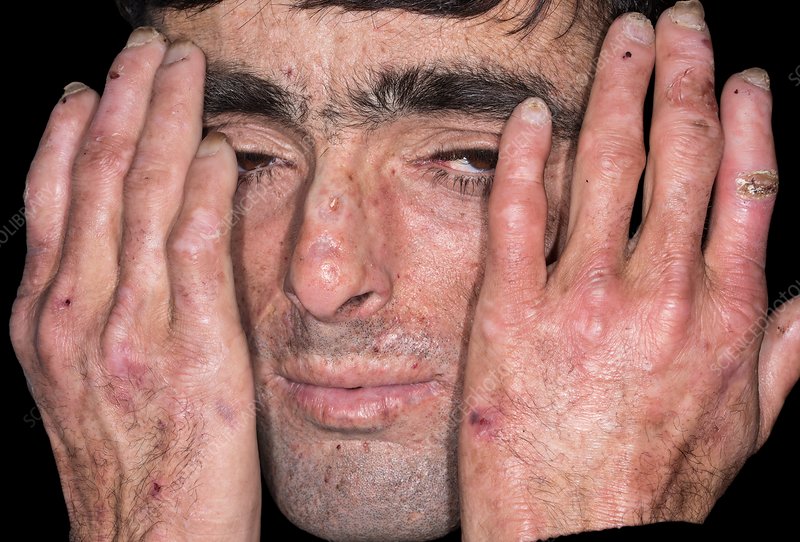Porphyria is a group of rare disorders that result from a problem in the production of heme, a vital component of hemoglobin, which helps red blood cells carry oxygen throughout the body. These disorders occur when certain enzymes in the heme production process are deficient or malfunctioning, leading to a buildup of porphyrins or their precursors. Porphyria is usually inherited but can also be triggered by factors such as certain medications, alcohol, hormonal changes, stress, or fasting. The condition is broadly classified into two types: acute porphyria, which affects the nervous system and causes symptoms like severe abdominal pain, vomiting, muscle weakness, and mental disturbances; and cutaneous porphyria, which affects the skin and leads to sensitivity to sunlight, blistering, and scarring. Diagnosis typically involves blood, urine, or stool tests, and sometimes genetic testing. While there is no cure, porphyria can be managed through lifestyle changes, avoiding known triggers, and specific treatments such as heme infusions or medications to reduce porphyrin levels, depending on the type and severity of the condition.

Types of Porphyria:
Porphyria is generally classified into two main types based on where the buildup occurs:
- Acute Porphyria (affects the nervous system)
- Symptoms include severe abdominal pain, vomiting, muscle weakness, seizures, and mental changes (like anxiety or confusion).
- Attacks may be triggered by stress, fasting, certain medications, or hormonal changes.
- Cutaneous Porphyria (affects the skin)
- Causes skin sensitivity to sunlight, blistering, redness, and scarring—especially on sun-exposed areas.
Some forms, like porphyria cutanea tarda (PCT), are more common and usually affect the skin, while others like acute intermittent porphyria (AIP) can cause dangerous attacks requiring hospitalization.
Causes of Porphyria:
Porphyria is primarily caused by a deficiency or malfunction of specific enzymes involved in the production of heme, a critical component of hemoglobin. In most cases, this enzyme deficiency is due to inherited genetic mutations passed down through families, making porphyria a largely genetic disorder. However, the symptoms or attacks of porphyria are often triggered by various environmental or lifestyle factors. These triggers can include certain medications (such as barbiturates or sulfa drugs), alcohol consumption, hormonal changes (especially in women during menstruation), fasting or crash dieting, smoking, stress, and infections. In cutaneous forms of porphyria, exposure to sunlight can also provoke symptoms. Additionally, some forms, like porphyria cutanea tarda (PCT), can be acquired rather than inherited. Acquired porphyria may result from conditions such as liver disease, iron overload, hepatitis C infection, or chronic alcohol use. While the underlying enzyme issue may be genetic or acquired, attacks typically occur when these triggering factors are present.
1. Genetic Causes (Inherited Mutations):
- Most types of porphyria are inherited, passed from parents to children.
- Mutations in genes responsible for producing enzymes in the heme pathway cause an enzyme deficiency, leading to a buildup of toxic substances (porphyrins or their precursors).
- Inherited porphyria may follow autosomal dominant or autosomal recessive patterns.
2. Triggers (Environmental or Lifestyle Factors):
These do not cause porphyria on their own but can trigger symptoms or attacks, especially in those with a genetic form:
- Certain medications (e.g., barbiturates, sulfa drugs, birth control pills)
- Alcohol consumption
- Fasting or crash dieting
- Hormonal changes (e.g., during menstruation)
- Smoking
- Stress
- Infections
- Exposure to sunlight (in cutaneous forms)
3. Acquired Factors:
- In some types like porphyria cutanea tarda (PCT), the condition can be acquired due to:
- Liver disease (e.g., hepatitis C)
- Excess iron in the body
- Heavy alcohol use
- Certain toxins or infections

Solutions for Porphyria (Management and Treatment):
The treatment and management of porphyria focus on preventing attacks, avoiding known triggers, and addressing symptoms when they occur. Since porphyria is often triggered by environmental and lifestyle factors, individuals are advised to avoid alcohol, smoking, fasting, stress, and certain medications known to provoke attacks. For acute porphyria, treatment may involve intravenous hemin therapy to reduce the buildup of harmful substances in the body, along with glucose infusions or a high-carbohydrate diet to help suppress the disease process. Pain relief, anti-nausea medications, and seizure control may also be necessary during attacks, using drugs that are safe for porphyria. In cutaneous forms, such as porphyria cutanea tarda, treatment may include phlebotomy (regular blood removal) to reduce iron levels or low-dose antimalarial drugs to eliminate excess porphyrins from the body. Sun protection is essential for managing skin symptoms, and wearing protective clothing and sunscreen can help prevent flare-ups. In all cases, maintaining a healthy, balanced diet and a stable lifestyle plays a key role. For inherited forms of porphyria, genetic counseling is recommended to help affected individuals and their families understand the condition and plan for future health decisions.
🔹 1. Avoiding Triggers:
- Avoid alcohol, smoking, and recreational drugs.
- Do not fast or follow crash diets; maintain a balanced diet.
- Avoid medications known to trigger attacks (e.g., certain antibiotics, hormonal treatments, sedatives).
- Limit sun exposure (for cutaneous types); use protective clothing and sunscreen.
- Manage stress and get adequate rest.
🔹 2. Medical Treatments:
For Acute Porphyria:
- Hemin (heme therapy): A medication given through an IV to reduce the buildup of porphyrin precursors.
- Glucose infusions or high-carb diet: Helps reduce the activity of the enzyme pathway and control mild attacks.
- Pain management: Using non-triggering pain relievers.
- Anti-nausea and anti-seizure medications (that are porphyria-safe).
For Cutaneous Porphyria (like PCT):
- Phlebotomy: Removing small amounts of blood to lower iron levels.
- Low-dose antimalarial drugs (e.g., hydroxychloroquine) to remove excess porphyrins.
- Sun protection: Clothing, broad-spectrum sunscreens, and avoiding sunlight.
🔹 3. Lifestyle Adjustments:
- Eat regular, balanced meals.
- Stay hydrated.
- Track symptoms and triggers.
- Use a medical ID bracelet or carry emergency information.
🔹 4. Genetic Counseling:
- Helpful for people with inherited forms and their families to understand risks and prevention strategies.
